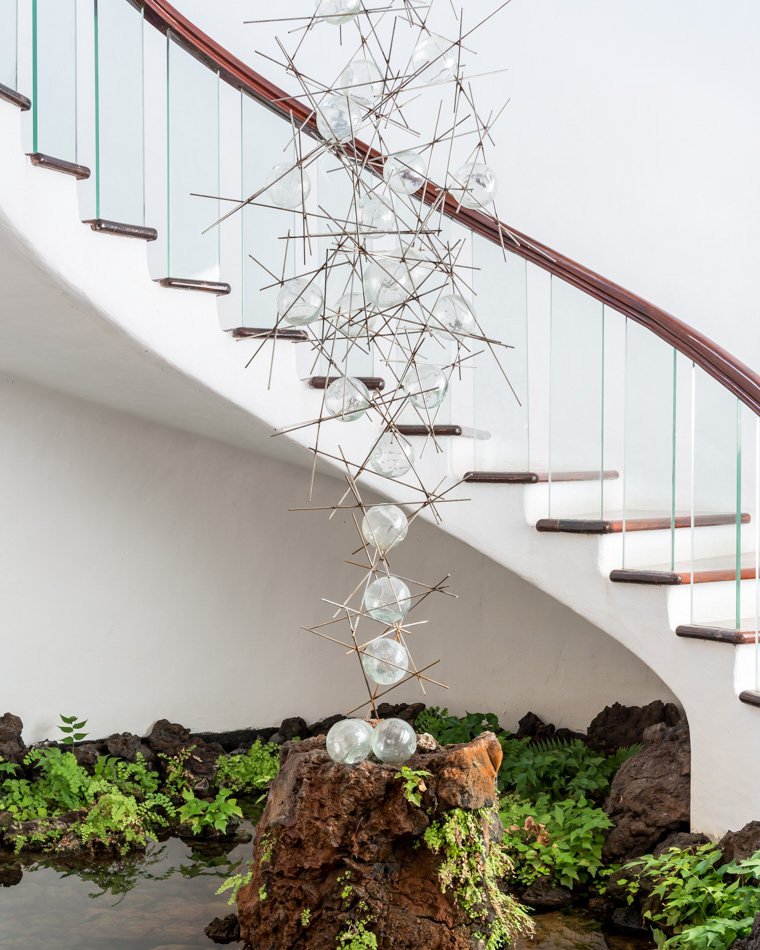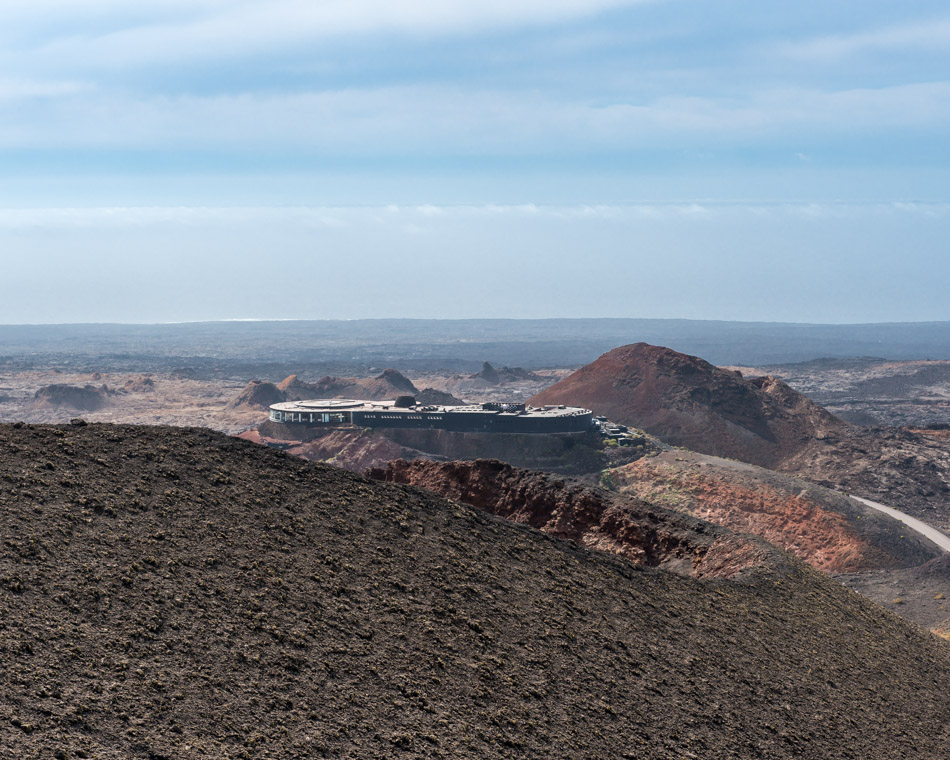When we visited Lanzarote in March this year on a family holiday, it felt like a compromise. OK, so it's probably going to be sunny, warm (it wasn't), and its only a few hours away - but there is no culture, and we'll have to spend the whole time ignoring package deal tourists, right? Wrong! We discovered an amazing island and the work of an amazing man, Cesar Manrique. So a few weeks later I was back again with my camera, shooting this story for the July edition of N by Norwegian, the in-flight magazine of Norwegian airlines, and the best one out there. Read on for the full article ...
The Man Who Designed Utopia - Words and Photographs by Alastair Philip Wiper
There is a place in Europe where there’s no advertising – no Coca-Cola signs or tacky billboards – and no high-rise buildings; where whitewashed villages sit amid jaw-dropping black volcanic landscapes; and where lairs worthy of a discerning James Bond villain are built into rivers of lava.
Welcome to Lanzarote, one of the first places in Europe to introduce package holidays in the 1970s, and an island many still imagine to be an all-inclusive tourist trap. The fact that it’s so much more than that is in large part down to one man: Cesar Manrique, the visionary artist and architect who not only peppered Lanzarote with sculptures, signs and stunning pieces of architecture, but lobbied authorities to develop sensitive “intelligent tourism”. It’s because of Manrique that there are no high-rises or advertising hoardings here. He once said: “I think this is the first place in Europe where all the advertisements have been removed from the landscape. I used to go around at night destroying the adverts. We have advertising in the press, on the radio, on TV, and also when you go to see the nature? Enough!”
Manrique was a true multidisciplinarian: a painter, a sculptor, an architect, a town planner, an ecologist, a landscape gardener and a campaigner all rolled into one. His most striking legacies are the fantastical attractions he carved into the volcanic landscape in the 1960s and 70s – the prime example being the Jameos Del Agua, a volcanic tunnel turned cultural centre that features a concert hall, two dance floors, three bars, an underground lake filled with blind albino crabs, a swimming pool that only the King of Spain is allowed to swim in, and a volcano museum that looks like something out of a Stanley Kubrick film. It’s a stunning feat of imagination that, almost 50 years later (it was opened in 1966), still feels strikingly fresh yet also in tune with the landscape.
Jameos Del Agua and Casa de los Volcanoes, (1966):
Manrique was born in Lanzarote in 1919, and died in a car crash in 1992, aged 73. He was born into a reasonably well-off middle-class family, studied architecture for two years, dropped out, and then travelled to Madrid to study art. After graduating, he went to New York, hung out with all the right people, and then returned to Lanzarote as a successful artist with a mission. “When I returned from New York, I came with the intention of turning my native island into one of the most beautiful places in the planet, due to the endless possibilities that Lanzarote had to offer… I made it a point to show Lanzarote to the world.”
Windmills:
With fire in his eyes, machine-gun speech and the grin of a mischevious boy, Cesar Manrique was quite a character. For the 2012 documentary Taro, el eco de Manrique (Taro, the echo of Manrique), director Miguel G. Morales’ trawled through hundreds of hours of footage of Manrique, and what emerges is a picture of a man with an almost cultish zeal. “Cesar Manrique is inexplicable without Lanzarote; Lanzarote is also inexplicable without Cesar Manrique,” says Fernando Gómez Aguilera, Director of the Cesar Manrique Foundation. “The blood of Cesar is in the island.”
But while his passion for the island ran deep, he lived the life of an ascetic workaholic. He didn’t smoke, didn’t drink, went to bed early and woke up early to run to his studio and begin work. “He was a great boss,” says Santiago Hernandez, one of Manrique’s longtime employees. “He took care of us like his children. If we were working, and he appeared by surprise in the studio, someone would shout ‘Cesar is coming!’, or ‘the old man’ as we used to call him. The first thing we had to do was hide our cigarettes, sometimes putting lit fags in our pockets. When he saw us smoking he got very angry and said we were losing everything, even our sexuality.”
According to Aguilera: “He was very funny, very enthusiastic, capable of transmitting his passion, very vehement about everything. He was a man of black and white, there were no medium tones for him.”
You can feel that in his creations, which balance art, nature and bold modernity: the Mirador del Rio, a 400m high viewpoint built into the cliff overlooking the island of La Graciosa; the Taro de Tahiche, Manrique’s private home between 1968 and 1990, which is dug out of underground volcanic bubbles; the Jardin de Cactus, a terraced garden featuring more than a thousand species of cactus from around the world; or the space-ship shaped panoramic restaurant in the volcanic Timanfaya National Park, where you can eat a meal cooked over hot lava.
Taro de Tachiche (1968):
Manrique’s home and studio for the last few years of his life has also recently been opened to visitors, exactly as it was on the day he walked out of it for the last time. All of these places are littered with Manrique's sculptures and artworks – as is the whole island, where huge colourful and intricate Manrique windmills and mobiles pop up on roundabouts and at the sides of roads. In true 60s style, most of the locations have a cocktail bar and a restaurant serving good, reasonably priced tapas, served by waiters wearing uniforms designed by Manrique himself. And the best bit? Everything has been preserved exactly as Manrique designed it, down to the smallest details – there’s not a dodgy 90s refurbishment in sight.
Mirador del Rio (1974):
Even the roads could not escape Manrique’s scrutiny. “He told me many times” says Luis Morales, the man in charge of building Manriques projects, “Luis, the roads must be like if you took a carpet and laid it on the landscape. Take care of the edges, clean them up and cover what the machine damages in order to match them to the environment. And we managed to make it seem like the lava stopped on the road. We had to do things correctly, thinking of the tourists that come here to see what they can’t see in other places. I learnt to see what I could not see.”
So how did Manrique pull all of this off? Who trusted Manrique, an eccentric artist, with a load of funding and some important geological sites to play around with? According to Alejandro Gonzalez of the Cesar Manrique Foundation, he could be very persuasive. “They all thought he was crazy. But Manrique was a very intense person, and he had decided that this was going his life’s work. Pepin Ramirez, one of Manrique’s childhood friends, had become a prominent politician and together they managed to get permission and funding. The Jameos would have been much cheaper to build then, because the skilled labour and knowledge of handcraft was more readily available. Today it would be impossible.”
Jardins de Cactus (1990):
After the success of Jameos, it became apparent that perhaps Manrique wasn’t so crazy after all. Gonzalez continues: “At the same time he was trying to educate the local people to build their houses using traditional techniques, reshaping the landscape as they had for hundreds of years instead of using cheap new materials. They were very sceptical at first, but now when you ask any of the old timers about Manrique they will tell you he is a master, a genius.”
The restaurant at Timanfaya National Park (1968):
Manrique faced his biggest challenge in the 80s, when the Canaries really started to become popular as a budget tourist destination. The developers moved in, and with the power of their wallets began a relentless tide of soulless construction that threatened to destroy everything he had worked for. Manrique began protesting at the building sites, lobbying the government and fighting to resist this development. “I don’t have any kind of patriotic romanticism,” he said in the early 90s. “I am a citizen of the world, and we have to have a feeling for the future, not a stupid and provincial mentality. I think the most beautiful feeling is to be a citizen of the world. But there is a speculative mafia in Lanzarote that I hate from the deepest place of my soul. Even Mussolini would not have allowed this fascist architecture, because it is horrible, terrible! But there is hope. Berlin was destroyed in during the war, it has been rebuilt into an extraordinary city. Even though we destroy the Canary Islands, there is always hope from people with fantasies, good and enthusiastic people.” The resorts of Puerto del Carmen and Costa Teguise continued to expand regardless of Manrique’s protestations, albeit without the high-rise apartment blocks that have plagued the other Canary Islands.
Casa del Campasino (1972):
After his death, the Fundaçion Cesar Manrique was established to continue Manrique’s work for the island, and in recent years they have brought to light a number of illegally built hotels. But they have not been able to stop the development of Playa Blanca, the island’s third resort, which has expanded rapidly in recent years. “It used to be just a pretty little fishing village,” explains Jose Amigo, owner of the small rustic hotel Casona de Yaiza in the middle of the island. “But instead of keeping the old town and developing it outwards, keeping the feel of the traditional buildings and creating high quality accommodation, they tore it all down and started to build massive hotels. Manrique wanted Lanzarote to be an island where there would be a queue to get in – but how can you create that kind of place when you build hotels that have 800 rooms?” Gonzalez agrees: “If Manrique saw Lanzarote today, I think he would be very sad about some parts of it. But as soon as you leave those parts, the beautiful island that he helped to create is exactly as he left it.”
Indeed, it is hard to disagree. The surprisingly elegant embrace of “intelligent tourism” and lack of traditional mass-tourism tat that embodies the “real” Lanzarote can only lead to the conclusion that Cesar Manrique’s mission was a success, and begs just one question: what other amazing things would he have built if he had lived longer? As Manrique’s employee Santiago Hernandez puts it “He left the island unfinished.” Filmaker Matthias Allery conducted the last known interview with Manrique before his death, and says: “What I found amazing about Cesar Manrique was – I don’t know how old he was, over 70 – his vitality, how bright he was, much more so than some guys at 20. It was also interesting to see him playing all the time, it didn't matter what he was doing, he was like a child playing with stones, shells, plants, colours … it was a big power he had inside him, and I admired him.”
So, if you go to Lanzarote, take a drive into the interior and look at it through the eyes of one of the world’s great tourism innovators. You won’t see a cheap package destination; you’ll see what the future was meant to look like.
Manrique's home and studio in Haria (1990-1997):













































